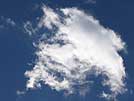Clouds represent a fabulous form of flow visualization that is available to everybody, almost every day.
Clouds can reveal a tremendous amount about the flows and physics of the atmosphere.
Instructions for the cloud assignment: Photograph a cloud.
In fact, photograph clouds as often as possible. You will soon discover that it is not easy to do but that it is a very
pleasant diversion from everything else that you do. Do keep track of where, when, and how the image was made. A report is
required. Seek atmospheric sounding data and discuss the physics revealed. Exceptional images made prior to this course are
acceptable; document them as best you can.
The most famous "cloud" photographs were made in black and white by the legendary early twentieth century New York art
dealer, photographer, and husband of Georgia O'Keefe, Alfred Steiglitz. He called them "equivalents" and considered them to be
music. Sunrise and sunset are sometimes quite colorful or even extraordinary, but difficult to picture in a satisfying way.
During the day, individual clouds can be extremely interesting. In the course of this assignment you will discover what the
English writer and amateur photographer George Bernard Shaw once said about the photographer: "The photographer is like the
cod (fish) who lays a million eggs so that one may hatch." So, keep looking up and keep pressing the button. And, if you have
access to an extreme wide angle lens as well as a telephoto lens, use them as needed and as often as possible.
Clouds require that you think outside the box.

2004 Gallery - Clouds 1
Rick Silva Cumulus and altocumulus. 9/13/04, 7pm, looking west from Boulder, Table Mesa Park'n'Ride. |
Laurel Swift The trees in the foreground echo the clouds in this image of cumulus and cumulonimbus, with some altocumulus above. 10/3/2004, 3:30 pm, looking east from north Boulder. More info. |
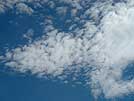 |
 |
 |
 |
|||
Chris Fauble Altocumulus undulatus, with possible mountain wave. 10/5/04, 12 pm. |
Clay Corbett A variety of clouds from cumulus to cirrostratus appear in a chaotic sky as a cold front approaches. More info. |
Sarah Robinson Cumulus. |
 |
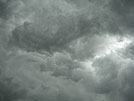 |
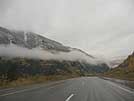 |
 |
|||
Lindsey Wohlman Cumulonimbus, 8/14/04, 6pm, near Berthoud, CO. |
Lauren Courtney 9/4/04, 5am. |
 |
 |
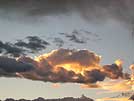 |
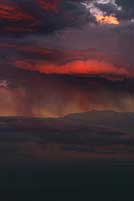 |
||
Katina Butler Stratocumulus, Boulder CO, 9/19/04, 7pm. |
© 2005 Jean Hertzberg. All rights reserved. - Web Site: Corey Simpson



